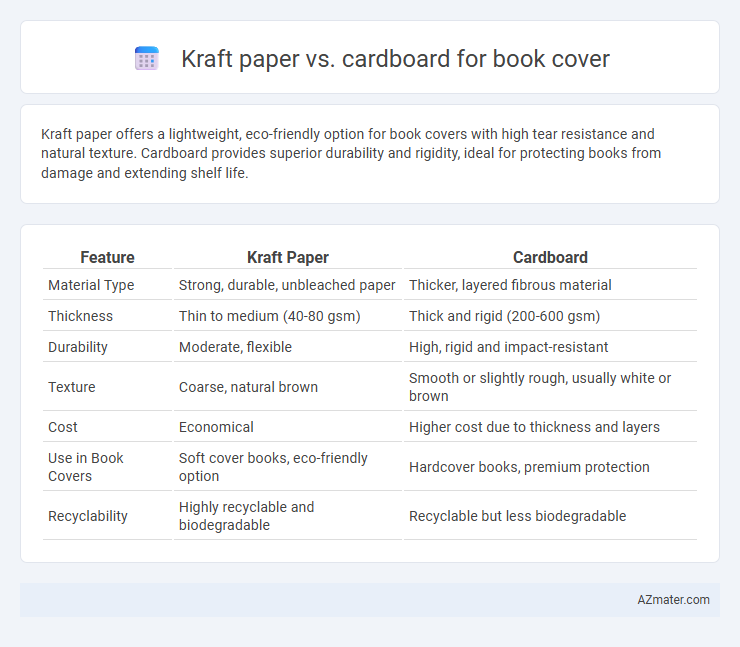Kraft paper offers a lightweight, eco-friendly option for book covers with high tear resistance and natural texture. Cardboard provides superior durability and rigidity, ideal for protecting books from damage and extending shelf life.
Table of Comparison
| Feature | Kraft Paper | Cardboard |
|---|---|---|
| Material Type | Strong, durable, unbleached paper | Thicker, layered fibrous material |
| Thickness | Thin to medium (40-80 gsm) | Thick and rigid (200-600 gsm) |
| Durability | Moderate, flexible | High, rigid and impact-resistant |
| Texture | Coarse, natural brown | Smooth or slightly rough, usually white or brown |
| Cost | Economical | Higher cost due to thickness and layers |
| Use in Book Covers | Soft cover books, eco-friendly option | Hardcover books, premium protection |
| Recyclability | Highly recyclable and biodegradable | Recyclable but less biodegradable |
Introduction to Kraft Paper and Cardboard
Kraft paper, made from wood pulp through the Kraft process, is known for its strength, durability, and natural brown color, making it a popular choice for eco-friendly and rustic-style book covers. Cardboard, typically thicker and composed of multiple layers of paper pulp, offers enhanced stiffness and protection, ideal for hardcover book covers requiring structural support. Choosing between Kraft paper and cardboard depends on desired aesthetic, durability, and protective qualities for the book.
Material Composition and Manufacturing
Kraft paper is made from wood pulp using the kraft process, which involves chemical pulping to remove lignin, resulting in a strong, durable, and flexible paper ideal for lightweight book covers. Cardboard, often composed of multiple layers of paper pulp or recycled fibers bonded together, offers greater thickness and rigidity, providing enhanced protection for hardcover books. Manufacturing kraft paper typically involves fewer layers and less processing time than cardboard, which requires additional pressing and bonding steps to achieve its sturdier structure.
Durability and Strength Comparison
Kraft paper offers moderate durability with resistance to tearing and moisture, making it suitable for lightweight, flexible book covers. Cardboard provides superior strength and rigidity, delivering enhanced protection against impacts and wear, which is ideal for heavy or hardcover books. The dense composition of cardboard ensures long-term durability, whereas kraft paper prioritizes eco-friendly and cost-effective attributes with less structural support.
Aesthetic Appeal and Texture
Kraft paper offers a natural, rustic aesthetic with a smooth yet slightly coarse texture that enhances the artisanal look of book covers. Cardboard provides a sturdier, more rigid surface with a smoother finish that supports a polished, professional appearance. Choosing between kraft paper and cardboard depends on the desired tactile experience and visual style of the book cover.
Environmental Impact and Sustainability
Kraft paper and cardboard differ significantly in environmental impact and sustainability for book covers; Kraft paper, made from natural wood pulp with minimal processing, is biodegradable and easier to recycle, promoting eco-friendly packaging. Cardboard, often thicker and more durable, can be more resource-intensive to produce but supports reuse and recycling when sourced from recycled materials. Selecting kraft paper reduces carbon footprint and waste, while cardboard offers longevity, with both requiring responsible sourcing to maximize environmental benefits.
Cost Considerations
Kraft paper offers a budget-friendly option for book covers due to its low material and production costs, making it ideal for bulk printing and eco-conscious publishers. Cardboard, while generally more expensive, provides superior durability and protection, justifying its higher price for premium editions or books requiring long-term preservation. Choosing between kraft paper and cardboard depends largely on balancing cost constraints with desired quality and durability for the book cover.
Printability and Customization
Kraft paper offers superior printability due to its smooth surface, enabling vibrant and detailed designs ideal for custom book covers. Cardboard, while sturdier, has a rougher texture that can limit print clarity and color accuracy but provides better structural protection. Customization on kraft paper allows for a wide range of finishes and printing techniques, whereas cardboard customization often focuses on embossing and die-cutting for enhanced tactile appeal.
Protection and Longevity for Books
Kraft paper and cardboard offer distinct advantages for book covers in terms of protection and longevity. Kraft paper is known for its durability and resistance to tearing and moisture, providing a protective layer that can help preserve the book's pages from environmental damage. Cardboard delivers superior strength and impact resistance, ensuring structural support and enhanced longevity by preventing bending and physical wear on the book's cover over time.
Popular Use Cases in Book Covering
Kraft paper is popular for book covers due to its durability, eco-friendliness, and rustic aesthetic, often used for wrapping textbooks and library books. Cardboard, being sturdier and thicker, is preferred in hardcover book covers, providing enhanced protection and structural support for premium editions and collectible books. Both materials excel in customizable printing, but kraft paper suits flexible, reusable covers while cardboard ensures long-lasting, rigid protection.
Choosing the Right Material for Your Book Cover
Kraft paper offers a rustic, eco-friendly aesthetic with flexibility and ease of customization, making it ideal for lightweight or artisanal book covers. In contrast, cardboard provides superior durability and structural support, perfect for hardcover books requiring long-lasting protection. Selecting the right material depends on balancing visual appeal, protection needs, and budget constraints to enhance both functionality and presentation.

Infographic: Kraft paper vs Cardboard for Book cover
 azmater.com
azmater.com